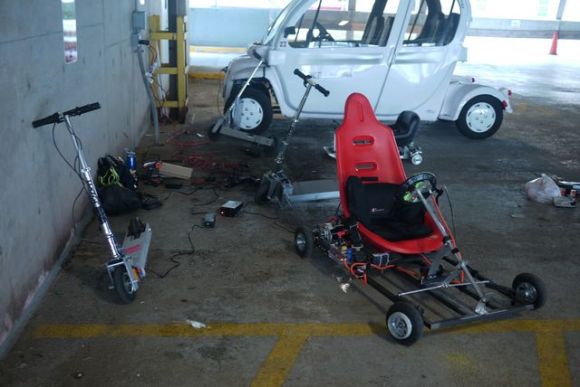We’re in Boston this week and my first stop was at MITERS last night. This is the MIT Electronics Research Society, which started as a way to provide free access to computers for all students. Since those humble beginnings the organization has grown to include a slew of fabrication and test hardware, as well as a vibrant community that makes the group a great place to hang out.

Doors leading to MITERS

Ah, the comfort of a hackerspace

Batteries on the bench

High-five bot

Funds are generated by Swapfest
Walking into the building you’re greeted with double doors strewn with interesting electronics and many examples of fabrication in the form of the word MITERS. The group, which is pushing 60-years of existence, feels immediately like a hackerspace where creativity and anarchy duke it out in a wild dance of experimentation. On this particular Wednesday evening we encountered a room of about 10 people working feverishly to fabricate electric racers for the PRS racing circuit in Detroit this Saturday.
Like a hackerspace, MITERS is completely member (read: student) run. There is a board that helps keep things on the rails. There is no membership fee; funding for the organization is sourced from Swapfest, a weekly flea market during the summer.

Machinist’s tool kit

Machine shop

CNC machine tools

Argh-argh-argh-argh
There is a strong slant toward machine shop at this hackerspace. In addition to a respectable Bridgeport CNC Mill, the machine tools and hand tools provide for almost all your fabrication needs.

Uni-balancer and it’s creator

Unibalancer

Black strip is the deadman switch
What can be built in this space? How about a unibalancer? This is a single-wheeled, human-ridable vehicle that has a 7-mile cruise radius between charges. For me the most interesting feature is the deadman’s switch. You know those black rubber strips on public buses that you press for the next stop? This unibalancer has one that you need to stand on to make it go.

Impressive PRS Build

Twin Ryobi electric chainsaw motors

Chainsaw using chain drives

Original Chainsaw batteries not used in racer

Wireless statistics on tablet

Another PRS build

Motorized shopping cart hangs from ceiling

Tiny electric racer
The hackers at MITERS excel when it comes to electric vehicles and this time of year that means the Power (Wheels) Racing Series. There are restrictions on size, and power output so the teams squeeze every bit that they can. For me, the most interesting build is based off of a pair of Ryobi electric chainsaws. The 40V batteries for these are themselves quite formidable but not used at all in the build. The team has reverse-engineered the driver circuits and written their own firmware for the STM8 microcontrollers on the boards. The chainsaws use chains to drive the two rear wheels. The entire system is monitored with XBEE-based wireless data which is displayed on a tablet.
This isn’t the only PRS build. The MITERS plan to take three different vehicles with them this weekend. The one they can’t bring is the huge electric shopping cart (with mandatory wheelie bar) which hangs from the ceiling of the space.

Best sounding musical Tesla I’ve seen

Top coil of massive tesla coil

Huge subwoofer
In addition to the formidable fabrication projects, there are a multitude of electronic projects to be seen. There is a musical tesla coil which is the best I’ve ever heard. It could easily be mistaken as a proper speaker. If you need more bass there’s a massive ceiling-mounted sub-woofer for that. And if you want a more formidable tesla coil, the parts are there.

Battle-bot

Underbot
Look hard enough and you’ll even find battle robots. This one had diamond plate that spins with a variety of nasty accoutrements intended for maximum damage of its foe. On the underside you’ll see a brushless motor used the opposite of how you might think. The shaft is attached to the locomotion frame of the bot. The underside of the spinning diamond plate has a ring of antistatic mat against which this brushless motor body spins.
Thanks to the MITERS for welcoming us in. It was a blast seeing all of the projects they’re working on!
Meetup at Artisan’s Asylum Tonight
If you’re in the Boston area, head on over to Artisan’s Asylum tonight starting at 6. They were gracious enough to open their doors for a Hackaday Meetup. Bring some hardware to show off if you can, if you can’t that’s fine as well. We’ll have a few lightning talks, some social time, and maybe an afterbar!
To wrap things up, we have covered a few projects from MITERS already, like this Power Wheels Racing build, and an electric go kart done the right way. Now that we’ve met them in person we’ll be on the lookout for a lot more awesome hacks from them.
[Thanks John for suggesting we stop by!]











































